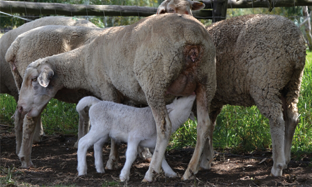
Johne’s Disease in Sheep (Questions and answers)
Gudair® is distributed by VIRBAC , for the prevention of Ovine Johne’s Disease (OJD).
Johne’s disease is a disease that leads to sheep to become emaciated which is caused by the bacteria Mycobacterium paratuberculosis, which is mainly found in the small intestine , resulting in the thickening of the intestinal wall.
The wall of the small intestine thickens gradually, causing a reduction in the absorption of digested nutrients.
The disease usually has a long incubation period of up to two years, but once the animals start to lose weight, they typically die within a short period between three to six months.
Diarrhoea can occur, but is not typical.
Merinos are more susceptible than crossbred sheep.
There is no effective treatment against this disease, except vaccination.
How does the disease spread?
The bacteria are excreted in large quantities in the sheep’s faeces.
Animals get infected by the bacteria via the mouth, from contaminated teats, grazing and water.
The bacteria can survive for many months in cool and moist areas.
How does the disease spread between farms?
Infected animals that are purchased from a positive farm is the main source.
Contaminated dung and run-off water can also spread the disease.
Why must I be aware of Johne’s?
In both Australia and South Africa, deaths of 10% and more are a reality if the disease is not controlled.
Recent research from New Zealand shows that the disease also can lead up to 17% reduction in weaning mass, as well as a 10% reduction in wool production.
How do I determine whether the disease is present in my flock?
There are usually no signs for the first few years.
The first sign is that animals appear to become unresponsive to the treatment for internal parasites – they stay emaciated and later die.
Sheep between the age of 2 to 3-year will most likely show signs of infection with OJD.
Approach your Vet as histopathology of the small intestine will confirm the disease. Alternatively, certain blood tests can be done, but these results are not always reliable.
TAKE NOTE: Johne’s is a Controlled Disease and the local State Veterinarian must be notified immediately, even if you only suspect that your animals may have the disease.
What can I do if the disease is present in my flock?
Slaughter all sheep exhibiting signs of emaciation as soon as possible.
Do not allow ewes to lamb and graze on very short grazing, or lands that are heavily contaminated with faeces..
Avoid giving supplemental feed directly on the ground, because faecal contamination regularly occurs here.
Keep the flock as young as possible.
Vaccinate replacement ewes lambs at a young age (4-6 weeks).
How do I use the Johne’s vaccine GUDAIR?
The vaccine is only available from your Private Veterinarian under prescription from the local State Veterinarian.
It is an inactivated (dead) vaccine that contains a mineral oil as adjuvant.
This adjuvant improves immunity , but is also responsible for local swelling.
The swelling occurs at the site of the injection and varies from the size of a pea to a golf ball. Sometimes a sterile abscess may form that heals by itself.
Farmers must take care not to inject themselves, because a similar swelling will occur that may require medical treatment.
The dosage is 1 mℓ under the subcutaneous, ONLY high on the neck, directly behind the ear .
It is administered to an animal ONLY ONCE in its lifetime.
It is available in 100 dose packs.
For more information, contact Trevor Brinch (Virbac) 072 123 7007.

